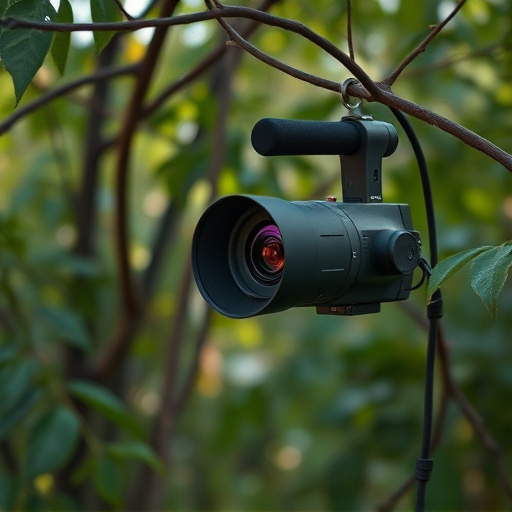Strategically place tiny cameras for home monitoring near windows or in corners for optimal visibility. Conceal them within decorative elements for discreet surveillance. Test camera locations and use signal boosters for better range and connectivity. AI-powered location analysis enhances accuracy, troubleshooting. Regular testing and calibration ensure maximum effectiveness.
Wireless surveillance equipment, particularly tiny cameras for home monitoring, offers unparalleled peace of mind. To maximize their effectiveness, strategic location detection is key. This guide explores essential tips on selecting discreet camera spots, maximizing signal strength, and concealing devices for optimal monitoring. Additionally, it delves into leveraging AI for intelligent analysis and the importance of regular coverage testing for continuous improvement.
- Selecting Discreet Wireless Camera Locations
- Maximizing Signal Strength for Accurate Detection
- Concealing Cameras for Optimal Home Monitoring
- Leveraging AI for Smart Location Analysis
- Regularly Testing Coverage for Continuous Improvement
Selecting Discreet Wireless Camera Locations
When it comes to selecting discreet locations for wireless surveillance cameras, especially with tiny cameras for home monitoring, the key is to think like a stealthy observer. Choose spots that offer optimal visibility while remaining hidden from view. For instance, mounting cameras near windows or strategic corners allows them to capture detailed footage without being obvious. Concealing these tiny cameras within decorative elements, such as plants, sculptures, or even light fixtures, can make them nearly invisible yet highly effective for home monitoring.
Remember, the goal is not just to place a camera but to integrate it seamlessly into your environment. Discreet placement ensures that your home remains secure while maintaining an aesthetically pleasing atmosphere. By selecting these hidden locations, you create a robust security system that operates without drawing attention—the ultimate in wireless surveillance equipment for peace of mind.
Maximizing Signal Strength for Accurate Detection
To achieve accurate detection with wireless surveillance equipment, maximizing signal strength is paramount. When utilizing tiny cameras for home monitoring, placement becomes crucial. Strategically position the devices in areas where they can capture clear images while ensuring optimal signal reception. Avoid placing them behind obstacles like thick walls or large pieces of furniture, as these can interfere with signal transmission.
Regularly test and adjust the camera locations to maintain peak performance. Consider using signal boosters or repeaters if the space is particularly challenging, helping to extend the range and enhance connectivity. Remember that a strong and consistent signal will lead to more reliable location detection, ensuring your home monitoring system operates at its highest efficiency.
Concealing Cameras for Optimal Home Monitoring
When it comes to home monitoring, one of the most effective tools are tiny cameras designed specifically for discrete surveillance. These cameras offer a level of discretion that traditional security systems lack, making them ideal for ensuring peace of mind without drawing unnecessary attention. Strategically placed in hard-to-see areas like corners or behind furniture, these tiny cameras can capture clear footage while remaining virtually invisible to potential intruders.
By integrating such devices into your home security setup, you gain 24/7 visibility into various rooms and outdoor spaces. Whether you’re checking on pets’ behavior while away at work or ensuring the safety of your family, these small but powerful surveillance tools provide valuable peace of mind and enhance your overall security measures.
Leveraging AI for Smart Location Analysis
Leveraging AI for Smart Location Analysis can significantly enhance the effectiveness of wireless surveillance equipment, especially when it comes to pinpointing tiny cameras for home monitoring. Advanced artificial intelligence algorithms are designed to process vast amounts of data from multiple sensors and feeds, allowing systems to not only locate devices but also predict potential blind spots or areas with reduced signal strength.
By integrating AI into location analysis, homeowners can ensure comprehensive coverage using discreet tiny cameras for home monitoring. This technology enables more precise adjustments in camera placement, ensuring optimal visibility and security without compromising privacy. Moreover, it helps in identifying the exact positions of surveillance equipment, facilitating efficient troubleshooting and maintenance.
Regularly Testing Coverage for Continuous Improvement
Regular testing and calibration are essential practices for optimal wireless surveillance equipment performance, especially with tiny cameras designed for home monitoring. These devices, often discreetly placed around your property, require regular checks to ensure they’re functioning at peak capacity. Start by evaluating signal strength in various areas of your home, identifying any dead zones or weak spots where the camera’s view might be obstructed. Adjust antenna placements and consider using signal boosters if necessary to improve coverage.
Continuously testing allows you to make informed adjustments, fine-tuning your wireless surveillance system for maximum effectiveness. Stay ahead of potential issues by regularly reviewing footage quality, ensuring clear and detailed images, and confirming that the equipment is picking up all relevant audio as well.
Wireless surveillance equipment, especially tiny cameras for home monitoring, offers unparalleled peace of mind. By strategically selecting discreet locations, maximizing signal strength, and leveraging AI for smart analysis, you can ensure optimal coverage. Regular testing ensures continuous improvement, allowing you to maintain a safe and secure environment. Concealing cameras further enhances their effectiveness, making them an indispensable tool for modern homeowners.
